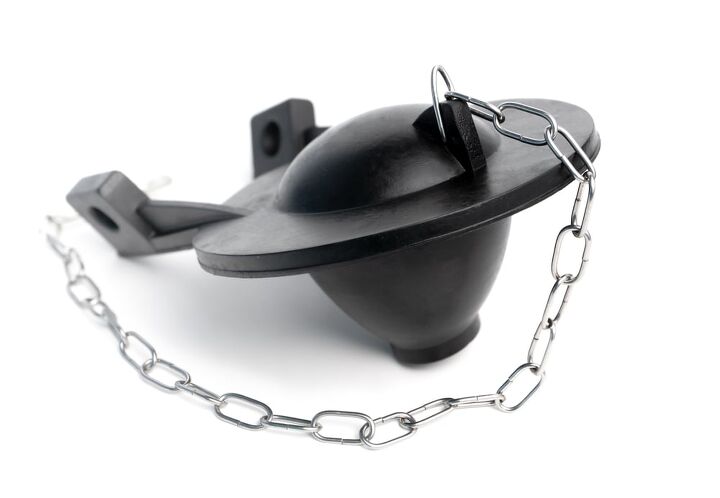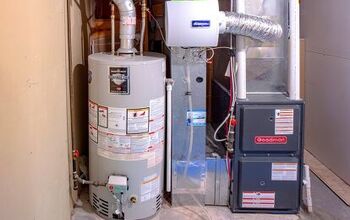Toilet Chain Keeps Coming Off? (Possible Causes & Fixes)

When it comes to our toilets, there are a plethora of components working at a given time. When one of those components stops functioning properly, it can play havoc on the functioning ability of your toilet. This primarily happens when it comes time to flush.
The toilet chain can keep coming off if there is too much slack or the flapper is out of place. Broken links in the chain and corrosion can cause it to continually come off. Incompatible parts in the toilet tank can prevent the chain from staying in place.
Do You Need to Hire a Plumber?
Get free, zero-commitment quotes from pro contractors near you.

Why Does the Toilet Chain Keep Falling Off?
There are more than a few reasons why the toilet chain keeps falling off. It could be the chain itself that is the issue. It could also be due to a component linked to the chain that fails and ultimately causes the chain to slide off.
A good way to tell that your chain is at fault is if you hear the toilet running constantly. Should you have to jiggle the handle a lot to get it to stop, that is another telltale sign that the chain is bad. You might even hear a slight metallic clanging; that is the chain banging up against the side of the tank or one of the other components.
Start with the Flapper
The very first place to look is the flapper. The flapper is more often than not at fault for many of the various issues that your toilet may be experiencing. If the flapper isn’t the cause, then it is more likely going to be the chain.
When the flapper is out of position, it will cause the toilet to keep running after flushing. Usually, an out-of-position flapper is due to the chain length or another chain-related issue. When the length is off, the chain will fall off even after you fix the issue.
Not Enough Slack in the Chain
The slackness of the chain plays an integral role in the toilet flushing. When the chain is either too loose or too tight, it can lead to the flapper sitting out of position. More often than not, the chain being too loose is the problem.
If the toilet chain is too short, it won’t allow the flapper to comfortably seat and seal in your toilet tank. Try loosening the slack of the chain to see if that improves the flushing experience. The chain can be fickle at times, so don’t be surprised if that does not remedy the issue immediately.
Too Much Slack in the Chain
On the other hand, when the chain has too much slack, then it won’t let the flapper seat properly. And more often than not, the chain will come off to boot. If your toilet keeps running even after adjusting it, then you probably have too much slack.
Try adjusting the slack on the chain. It is a precarious dance to make the chain the right length. It may take a few frustrating attempts to get it just right. If you notice that even after a few adjustments the chain still falls off, then there are other issues at play.
Related Guide: Toilet Chain Keeps Getting Tangled?
Corrosion on the Chain
Over time, it is not uncommon for the chain to corrode in some way. Take the tank off and take a close look at the condition of your chain. Should you notice that there is a lot of corrosion or rust on it, you will have to replace it.
The good news is that you can find replacements online pretty easily. Consider going with a stainless steel option as it can stand up to corrosion over time far better. Not the worst fix in the world but one that could be avoided.
Broken Links
Should you find yourself struggling to keep the chain at the proper length then it could be a case of a middle link having broken off. Like the issue with the chain being at the improper length, a missing link can lead to poor flapper position.
Even if the chain looks to be beyond repair, you can more often than not replace the linkages so long as they are in the middle of the chain. You simply need to connect the middle pieces and bend them with some needle-nose pliers. Just make sure that they are straight so that they won’t pull apart again.
Incompatible Parts
Toilet parts are certainly not universal. For those who have just purchased a home, in particular, you never know what the person before you may have done for a fix. If the chain keeps falling off, it could simply be that it does not match up with incompatible parts within the toilet tank.
Fixtures like the toilet have a history of repair, generally speaking. Even toilets will have small fixes implemented from time to time. Granted, if you are buying a brand-new toilet, this is not likely to be an issue. But if you have just moved in and your toilet is causing your problems, that may be why.
How to Replace a Toilet Flapper Chain
Perhaps your toilet chain just keeps falling off no matter what you do. Sooner or later, it is going to come down to replacing the thing entirely. The good news is that it is relatively easy to replace the old chain with a new one.
If you are going to replace the chain, it is highly recommended that you replace the flapper, too. The flapper and the lift chain act as a cohesive unit so you don’t want to run the risk of getting a chain that won’t work well. Besides, they are relatively cheap so it’s not a big deal to get a new one.
Step 1: Turn Off and Remove the Water
Start off by turning off the water supply to the toilet tank. The last thing you want to contend with when making your repairs is more water. The valve is either located on the wall behind or directly to the left of the toilet. Turn clockwise to close off the flow of water to the toilet.
Follow that up by flushing all the water out of the tank. Should the lift chain or flush lever be disconnected, then you can just manually lift the flapper up to flush the toilet. When the water has been drained out of the tank, you are ready to proceed.
Step 2: Replacing the Flapper
This part is pretty simple. Just unclip the chain from the flapper as well as the flush lever. Don’t just snap it off; it should unclip pretty easily. You are then in the free and clear to replace the old flapper with the new one.
After replacing the old flapper, make sure that the new lift chain is properly connected to the flapper. With that connection secure, you can then clip one of the clips to the flush lever. That is all there is to the installation.
Step 3: Try it Out
Put the flapper in place and turn the water supply back on. Give it enough time to properly replace the water in the tank again before giving it a shot. More often than not, it should flush as it normally would.
Should the new flapper not sit right, you will have to tweak the length of the chain. Remember that too much or too little slack and you run the risk of the lift chain falling off frequently. That is just another pain to have to deal with.
How Tight or Loose Should a Lift Chain Be?
After reading through this guide, there is one clear item: the length of the chain matters. The good news is that you can make that determination yourself. The bad news is that it takes some trial and error to determine the proper length of the lift chain in your toilet.
Adjusting the chain is pretty easy, too. Just keep in mind that if the chain is too loose, some of it can actually get beneath the flapper and keep it from sealing. To adjust, just make sure that you turn the water supply to the tank off first.
Make your adjustments to the chain by taking out the pin at the end of the flush lever and moving it a few places down the chain. Ensure that the lift chain is properly attached to the flush lever and then turn the water supply on again. Find out why your toilet flushes slowly.
Do You Need to Hire a Plumber?
Get free, zero-commitment quotes from pro contractors near you.

When in Doubt Call a Professional
For the most part, the issue of a loose chain or one that falls off can be resolved by even amateur DIYers. That said, there are other potential issues that may be at play here. If you have tried several things only to have the chain continue to fall off, then it might be time to bring a pro in.
Not only can they troubleshoot the issue, but they may be able to spot a problem that would otherwise go missed. Not only that, but they would be able to solve the problem sooner rather than later.
Related Articles

Ryan Womeldorf has more than a decade of experience writing. He loves to blog about construction, plumbing, and other home topics. Ryan also loves hockey and a lifelong Buffalo sports fan.
More by Ryan Womeldorf



























